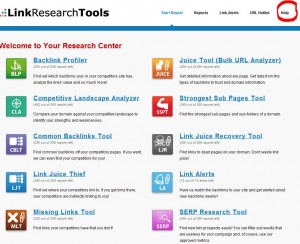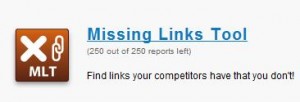Link Building Tool Review: Link Research Tool Set By CEMPER
Beginning today, my Link Week column will be devoted to link building tool reviews. Each review will focus on how the tool works and provide tips on how you can use the results to build links. If you’re on the fence about buying a tool, hopefully my reviews will help with your decision making process. The […]
 Beginning today, my Link Week column will be devoted to link building tool reviews. Each review will focus on how the tool works and provide tips on how you can use the results to build links. If you’re on the fence about buying a tool, hopefully my reviews will help with your decision making process.
Beginning today, my Link Week column will be devoted to link building tool reviews. Each review will focus on how the tool works and provide tips on how you can use the results to build links. If you’re on the fence about buying a tool, hopefully my reviews will help with your decision making process.
The review is not an endorsement by Search Engine Land or myself, it’s simply an outline to help you understand how the tool can be used. The test sites I’m using are all willing participants, I have permission from their owners to review and publish what I find in their back links.
Each tool owner agreed to give me, at no charge, a full membership for 60 days to use at my convenience. Representatives from the tool companies will be available to answer questions so please leave your feedback in the comments below. Now, on to the review!
Link Research Tools By CEMPER.com
In 2003,Christoph Cemper and his staff opened CEMPER.com, a full service SEO company based in beautiful Vienna Austria. Link Research Tools was launched in 2009 and is offered in both English and German.
I worked with Sebastian Moser, Cemper.com’s Director of IT Services who gave me full access to their tool and patiently answered all my questions. Thanks Sebastian and Christoph for agreeing to participate and for all of your help!
Dank Sebastian und Christoph für all Ihre Hilfe:)
The Set Up
The Link Research Tool (LRT) is made up of ten individual tools, all can be used to find link building opportunities as well as monitor your competition. Each tool has a written and video tutorial behind it, there’s also a Help and Feedback link on each page in the event you need information not provided onsite.
I strongly recommend watching the videos before using the tools, they’re helpful and will cut your learning time in half. I was given an unlimited SuperHero account which is the premier (most expensive) package LRT offers, it allowed me to use everything and rebrand PDF reports with my logo.
LRT provides a sign up page for your API information, if a particular tool calls for an API key, they can be accessed with a single click. Again, this is a huge time saver I recommend using if you have SEOMoz, Sistrix or SEMRush API tools.
SEOMoz provides a free 30 day API key via LRT, the other two do not. If you don’t have accounts at SEMRush or Sistrix and don’t want to register at SEOMoz, LRT will still work. According to Sebastian, they pull from 21 link sources. He did admit to using Yahoo! (for now) but could not, for competitive reasons, name the other 20 sources.
With ten individual tools in the LRT toolset, there’s something for everyone. While there is overlap between some of the tools because of the metrics used, you can take a complete tour of what’s offered and select a pricing option that fits your marketing budget. Let’s take a look at a number of the tools within the Link Research Tool (LRT) set.
Competitive Landscape Analyzer
The Competitive Landscape Analyzer allows you to compare multiple URL’s using pre-selected metrics ( anchor text, theme, page loading speed, number of retweets, etc) for selected keyword phrases.
There are multiple ways to use the data returned, I found these three most helpful:
1. The tool reports the unique number of pages hosting links to a site/page. Search behind your competitors and take a look at who’s linking to them, if you find good partner sites, work to secure links from these pages. If they won’t link to you, get links from the pages linking to them.
2. You can see the anchor text used to link to a page/site, if your competitors are using keyword phrases in their anchors and ranking ahead of you, they may have figured out what’s converting and/or have figured out how to tweak a term to rank. If they’re outranking you in both Google and Bing, it might be a good idea to spend time researching and testing new anchors.
3. I really liked the retweet/G+1/Facebook Likes metrics the tool allows you to select, being able to see the number of social media mentions a page is getting can be very helpful in developing your social media plan.
TIP: The reporting form can be tweaked to list the pages with the highest number of (Twitter) retweets.
Visit those pages and follow all the people who retweeted that content. Or use tools like Export.ly and Buzzom to help find and manage large amounts of Twitter data.
Make a point to follow people who retweet your content or that of your competitor, a percentage will follow back. Be sure to showcase your archived as well as new content when retweeting as a way to stimulate new followers.
Backlink Profiler

I loved the pie charts and graph options, they were a nice break from spreadsheets!
This tool also offers a unique, proprietary metric known as the CEMPER Juice™ Indicator, which tells you the “juicyness of a page in detail”.
Here’s the outline they provide to explain the various features of the metric:
I had a difficult time understanding the “Juice” component behind this metric based on what I read and heard in the video tutorial, so I emailed Sebastian for clarification.
In a nutshell, “Juice” is a ranking component CEMPER.COM has integrated into the proprietary algorithm powering their tools, it determines the weight and quality factors of a page hosting your link. “Juice” answers the question: “does the page hosting your link rank well for a specific term?”
The algorithm makes a distinction between the page ranking well, being indexed and being cached and this distinction is what produces the “juicyness” factor. So basically, “juicy” pages are those ranking well for specific keyword terms.
For example, the Backlink Profiler crawls links pointing to a domain/page and calculates the “Juice” score based on how that anchor text phrase ranks.
High ranking pages are “juicy” and display a high numerical number (up to 25) plus the word “Juice”. Other pages, based on their criteria, are returned DEAD, DUPE, JUICED, etc. (see outline above)
While I agree it’s helpful to identify high ranking pages hosting keyword rich anchor text links and understand calling the term “Juice” sounds better than “anchor text rank checker”, that’s basically what it is.
I get that the term “Juice” and “juicy” are fun and help make the Link Research Toolset unique but I doubt anyone new to SEO will understand the strategy behind this important metric after reading the descriptions or watching the video tutorial. When I brought this point up, Sebastian agreed and mentioned they were working on upgrading their copy points.
Link Juice Thief
This tool reports outgoing links from a specific URL or multiple URL’s. The tactical implementation of this option is simple: identify your competitors outbound links and work to secure links from the sites they are linking to.
For example, if Competitor A links to Site B, you can work to get a link directly from Site B and benefit indirectly from the flow of link popularity from Competitor A. Is this tactic worth pursuing? Depends on the amount of time you have and the quality of sites A and B.
TIP: I wouldn’t make this a priority, but if you’re looking to diversify your link portfolio, this is a good tactic.
Missing Links Tool
The Missing Link Tool compares your backlinks against your competitors and returns a list of domains where they (your competitors) have links but you don’t. (Sweet!)
There isn’t much more to explain here, but I wanted to point out the Competing Pages option which is circled in red below. This is a handy feature and allows you to search by keyword phrase for competitors URL’s and add them to the list of sites to compare.
It will take up to ten (10) additional sites per report and exports the data to spreadsheets for easy review.
TIP: When searching for URL’s to use with this tool, plug all of your primary, secondary (long-tail) and geographic keywords in the box. Then, expand your search by using category terms plus your keywords.
For example:
- memory foam mattresses
- memory foam beds
- memory foam mattress Virginia
- memory foam mattress blog
Category terms can be blog, news, video, image, forum, directory, travel, camping, etc. The idea here is to stretch your terms and tap into as many different types of sites and platforms as you can hosting terminology and content similar to yours. We tend to focus on a set circle of competitors when we use link comparison tools, this exercise will help you discover many new URL’s to spy on.
Link Juice Recovery Tool
This recovery tool will find dead pages on your domain (or someone else’s) and checks those pages for inbound links.
It happens all the time, your site gets bigger and pages go missing (return a 404) when you update or redesign. This tool will find those lost pages and list their inbound links.
Contact the webmasters linking to you and ask if they’ll point a link to a new page on your site. Or, redirect the page to another on your site. The first option is preferable but be prepared to lose some links, webmasters are busy people and don’t/can’t always honor your request.
TIP: Sweeten the change of link request with an incentive.
TIP: Run the tool using your top competitors URL’s. Find their broken pages with inbound links and offer your content as a replacement.
The SERP Research Tool
The SERP Research Tool reminds me of a Swiss Army Knife, it’s all purpose and can be used for a ton of different tactics! This tool has many functions, but the two I like best are the ability to search by type of site (general results, discussion, forum and Q&A) and the ability to change the data without having to rerun a new report.
For example, if I was looking for a list of discussion sites using three of my keywords, and each site had to have at least 10 inbound links plus an active Twitter account, I can set and run the program to return a list of sites matching my criteria.
If I wanted to change the Twitter criteria to Facebook, I simply click the Facebook column and the data will display. The best use for this tool can be found in my next tip…
TIP: Once you’ve exhausted your keywords, search on the URL of your competitors and/or any site ranking well for your keywords. The tool will bring back the sites/pages hosting the URL which in turn shows where they’re linking and who’s talking/writing about them. This single snapshot of competitive URL’s can be a goldmine and used for more than link building.
General Comments
Link Research Tools offers to store your reports but there are limitations on the length of time. Pull your results into your computer so you don’t lose anything.
LRT has a “Link Alerts” option, I have several going so I didn’t implement this one but I did review and liked the “dropped links” feature. Link Alerts keeps track of links they find and if those links are dropped, it will report the drop to you.
This can be helpful in keeping track of reciprocal links and temporary link promotions. It’s also great as a secondary link tactic, if you find a link has disappeared and you want to keep it, contact the webmaster and ask why it was dropped. You may be able to get it back or negotiate a better link!
Take advantage of the Feedback feature LRT offers, the staff is friendly and will answer any question you have.
Become familiar with the “Hotlist” feature included with most of the tools. You can save an URL into the Hotlist whenever you find something interesting and go back to it when you have time.
I used it when I found people “borrowing” my content without permission; when I was done with my testing, I went back to the list and exported the URL’s for follow-up. The Hotlist feature is a handy way to save URL’s without stopping your workflow.
The Link Research Toolset has something for everyone, with ten tools available you can stay busy for weeks! Take time to watch the videos and read the tutorials, understand fully what each can do before you start running reports.
Before I Close…
Two things before I sign off. We have tool reviews scheduled through May 2012 and do not plan to add more at this time. However, we may reopen the review program in the spring of 2012, so if you have a tool devoted exclusively to link building and would like to be considered for the tool review program, please drop me a note.
Until next time, good linking!
Contributing authors are invited to create content for Search Engine Land and are chosen for their expertise and contribution to the search community. Our contributors work under the oversight of the editorial staff and contributions are checked for quality and relevance to our readers. The opinions they express are their own.
Related stories










